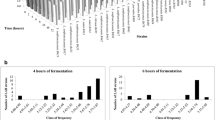Abstract
The aim of this study was to assess the mode of carbohydrate catabolism by lactic acid bacteria isolated from traditional sourdoughs, as well as to study their effect on the metabolites produced. For this purpose, single cultures of the heterofermentative lactic acid bacteria Lactobacillus sanfranciscensis, Lactobacillus brevis, Weissella cibaria, and the homofermentative Lactobacillus paralimentarius and Pediococcus pentosaceus were grown in liquid media containing glucose, fructose, maltose and sucrose, either as a single carbon source or in combination with glucose. Carbon catabolism and the production of metabolites were determined by HPLC analysis. W. cibaria could ferment all carbon sources, L. sanfranciscensis, L. paralimentarius and P. pentosaceus could not ferment sucrose, while L. brevis could only ferment maltose. The presence of glucose did not influence the utilization of fructose and maltose by L. sanfranciscensis, while it repressed the fermentation of fructose, maltose and sucrose by W. cibaria, and fructose and maltose by L. paralimentarius and P. pentosaceus. Moreover, L. sanfranciscensis and L. brevis could obtain extra ATP through the reduction of fructose to mannitol, which favored the production of acetic acid against ethanol. The utilization of fructose as an electron acceptor has a decisive effect on the prevailing of L. sanfranciscensis and L. brevis in spontaneously fermented sourdough and in the scarce appearance of the other lactic acid bacteria studied.
Similar content being viewed by others
References
Collar C, Andreu P, Martinez-Anaya MA (1998) Interactive effects of flour, starter and enzyme on bread dough machinability. Z Lebensm Unters Forsch 207:133–139
Corsetti A, Gobbetti M, Balestrieri F, Paoletti F, Russi L, Rossi J (1998a) Sourdough lactic acid bacteria effects on bread firmness and staling. J Food Sci 63:347–351
Corsetti A, Gobbetti M, Rossi J, Damiani P (1998b) Antimould activity of sourdough lactic acid bacteria: identification of a mixture of organic acids produced by Lactobacillus sanfrancisco CB1. Appl Microbiol Biotechnol 50:253–256
Corsetti A, Gobbetti M, De Marco B, Balestrieri F, Paoletti F, Russi L, Rossi J (2000) Combined effect of sourdough lactic acid bacteria and additives on bread firmness and staling. J Agric Food Chem 48:3044–3051
Damiani P, Gobbeti M, Cossignani L, Corsetti A, Simonetti MS, Rossi J (1996) The sourdough microflora. Characterization of hetero- and homofermentative lactic acid bacteria, yeasts and their interactions on the basis of the volatile compounds produced. Lebens-Wiss u-Tecnhol 29:63–70
De Vuyst L, Schrijvers V, Paramithiotis S, Hoste B, Vancanneyt M, Swings J, Kalantzopoulos G, Tsakalidou E, Messens W (2002) The biodiversity of lactic acid bacteria in Greek traditional wheat sourdoughs is reflected in both composition and metabolite formation. Appl Environm Microbiol 68:6059–6069
Gobbetti M (1998) The sourdough microflora: interactions of lactic acid bacteria and yeasts. Trends Food Sci Technol 9:267–274
Gobbetti M, Corsetti A (1997) Lactobacillus sanfrancisco a key sourdough lactic acid bacterium: a review. Food Microbiol 14:175–187
Gobbetti M, Corsetti A, Rossi J (1995) Maltose–fructose co-fermentation by Lactobacillus brevis subsp. lindneri CB1 fructose-negative strain. Appl Microbiol Biotechnol 42:939–944
Hammes WP, Stolz P, Gaenzle M (1996) Metabolism of lactobacilli in traditional sourdoughs. Adv Food Sci 18:176–184
Hansen A, Hansen B (1996) Flavour of sourdough wheat bread crumb. Z Lebensm Unters Forsch 202:244–249
Lavermicocca P, Valerio F, Evidente A, Lazzaroni S, Corsetti A, Gobbetti M (2000) Purification and characterisation of novel antifungal compounds from the sourdough Lactobacillus plantarum strain 21B. Appl Environm Microbiol 66:4084–4090
Liljeberg HGM, Lonner CH, Bjorck IME (1995) Sourdough fermentation or addition of organic acids or corresponding salts to bread improves nutritional properties of starch in healthy humans. J Nutr 125:1503–1511
Lopez HW, Krespine V, Guy C, Messager A, Demigne C, Remesy C (2001) Prolonged fermentation of whole wheat sourdough reduces phytate level and increases soluble magnesium. J Agric Food Chem 49:2657–2662
Martinez-Anaya MA, Pitarch B, Bayarri P, Benedito de Barber C (1990) Microflora of the sourdoughs of wheat flour bread. X Interactions between yeasts and lactic acid bacteria in wheat doughs and their effects on bread quality. Cereal Chem 67:85–91
Neubauer H, Glaasker E, Hammes WP, Poolman B, Konings WN (1994) Mechanism of maltose uptake and glucose excretion in Lactobacillus sanfrancisco. J Bacteriol 176:3007–3012
Paramithiotis S (2001) Study on the symbiosis of wild yeast and lactic acid bacteria strains in sourdough. Greece, Agricultural University of Athens, PhD Thesis, pp. 54–88
Paramithiotis S, Mueller MRA, Ehrmann MA, Tsakalidou E, Seiler H, Vogel R, Kalantzopoulos G (2000) Polyphasic identification of wild yeast strains isolated from Greek sourdoughs. Systemat Appl Microbiol 23:156–164
Roecken W (1996) Applied aspects of sourdough fermentation. Adv Food Sci 18:212–216
Roecken W, Voysey PA (1995) Sourdough fermentation in bread making. J Appl Bacteriol Symposium Supplement 79:38S-48S
Stolz P, Boecker G, Hammes WP, Vogel RF (1995a) Utilization of electron acceptors by lactobacilli isolated from sourdough I. Lactobacillus sanfrancisco. Z Lebensm Unters Forsch 201:91–96
Stolz P, Vogel RF, Hammes WP (1995b) Utilization of electron acceptors by lactobacilli isolated from sourdough I. Lactobacillus pontis, L. reuteri, L. amylovorus and L. fermentum. Z Lebensm Unters Forsch 201:402–410
Stolz P, Boecker G, Vogel RF, Hammes P (1993) Utilization of maltose and glucose by lactobacilli isolated from sourdough. FEMS Microbiol Lett 109:237–242
Vogel R, Knorr R, Mueller MRA, Steudel U, Gaenzle MG, Ehrmann MA (1999) Non-dairy lactic fermentations: the cereal world. Antonie van Leeuwenhoek 76:403–411
Acknowledgments
This work was carried out in the framework of the FAIR-CT96-1126 project. Spiros Paramithiotis wishes to thank the State Scholarship Foundation of Greece (IKY) for financial support.
Author information
Authors and Affiliations
Corresponding author
Rights and permissions
About this article
Cite this article
Paramithiotis, S., Sofou, A., Tsakalidou, E. et al. Flour carbohydrate catabolism and metabolite production by sourdough lactic acid bacteria. World J Microbiol Biotechnol 23, 1417–1423 (2007). https://doi.org/10.1007/s11274-007-9384-9
Received:
Accepted:
Published:
Issue Date:
DOI: https://doi.org/10.1007/s11274-007-9384-9




